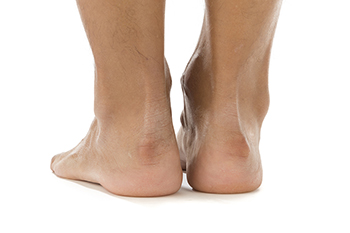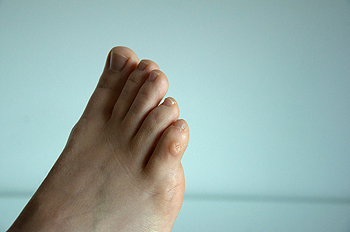Connect With Us
Blog
Items filtered by date: July 2023
Are Bunions Affecting Your Everyday Life?
What Is a Haglund’s Deformity?

Haglund's deformity is a foot abnormality where the heel bone and soft tissues develop an enlarged bony section at the Achilles insertion, causing heel pain and swelling. It is linked to retrocalcaneal bursitis, often referred to as "pump bump" or "winter heel" due to pressure from pump-style shoes. This condition commonly affects runners and women aged 15 to 35, particularly those who wear high heels. Factors such as genetics, high arches, tight Achilles tendon, and walking on the outer heel edge contribute to its formation. Wearing tight or ill-fitting shoes also exacerbates the condition. Treatment ranges from anti-inflammatories to surgery to remove the bony protrusion. If you have a bump on the back of your heel that causes foot pain, it is suggested that you consult a podiatrist for an accurate diagnosis and appropriate treatment.
Heel spurs can be incredibly painful and sometimes may make you unable to participate in physical activities. To get medical care for your heel spurs, contact Dr. Royall from Mountain View Foot & Ankle Clinic. Our doctor will do everything possible to treat your condition.
Heels Spurs
Heel spurs are formed by calcium deposits on the back of the foot where the heel is. This can also be caused by small fragments of bone breaking off one section of the foot, attaching onto the back of the foot. Heel spurs can also be bone growth on the back of the foot and may grow in the direction of the arch of the foot.
Older individuals usually suffer from heel spurs and pain sometimes intensifies with age. One of the main condition's spurs are related to is plantar fasciitis.
Pain
The pain associated with spurs is often because of weight placed on the feet. When someone is walking, their entire weight is concentrated on the feet. Bone spurs then have the tendency to affect other bones and tissues around the foot. As the pain continues, the feet will become tender and sensitive over time.
Treatments
There are many ways to treat heel spurs. If one is suffering from heel spurs in conjunction with pain, there are several methods for healing. Medication, surgery, and herbal care are some options.
If you have any questions feel free to contact our office located in Lehi, UT . We offer the latest in diagnostic and treatment technology to meet your needs.
Causes of Peripheral Neuropathy

The body is full of nerves whose main job is to let us touch and feel, as well as to warn us of dangerous conditions. The peripheral nervous system contains nerves in the lower extremities. When these nerves become damaged, they are unable to signal the toes and feet when something goes wrong. This condition is known as peripheral neuropathy. Symptoms of peripheral neuropathy are numbness, pain, and weakness. Causes include excessive use of alcohol, certain types of medication, vitamin B12 deficiency, and heredity. Other causes are infections, such as shingles and Lyme disease, as well as tumors and diabetes. Many diabetics develop peripheral neuropathy, which leaves them unable to detect sores and cuts on the feet. If left unattended, a cut or sore may turn into a diabetic foot ulcer that can become gangrenous and endanger the limb itself. Such diabetic neuropathy is the result of maintaining high levels of blood sugar that damage the nerves serving the feet. If you are experiencing any level of neuropathy in the toes, feet, or ankles, it is suggested that you consult a podiatrist as soon as possible.
Neuropathy
Neuropathy can be a potentially serious condition, especially if it is left undiagnosed. If you have any concerns that you may be experiencing nerve loss in your feet, consult with Dr. Royall from Mountain View Foot & Ankle Clinic. Our doctor will assess your condition and provide you with quality foot and ankle treatment for neuropathy.
What Is Neuropathy?
Neuropathy is a condition that leads to damage to the nerves in the body. Peripheral neuropathy, or neuropathy that affects your peripheral nervous system, usually occurs in the feet. Neuropathy can be triggered by a number of different causes. Such causes include diabetes, infections, cancers, disorders, and toxic substances.
Symptoms of Neuropathy Include:
- Numbness
- Sensation loss
- Prickling and tingling sensations
- Throbbing, freezing, burning pains
- Muscle weakness
Those with diabetes are at serious risk due to being unable to feel an ulcer on their feet. Diabetics usually also suffer from poor blood circulation. This can lead to the wound not healing, infections occurring, and the limb may have to be amputated.
Treatment
To treat neuropathy in the foot, podiatrists will first diagnose the cause of the neuropathy. Figuring out the underlying cause of the neuropathy will allow the podiatrist to prescribe the best treatment, whether it be caused by diabetes, toxic substance exposure, infection, etc. If the nerve has not died, then it’s possible that sensation may be able to return to the foot.
Pain medication may be issued for pain. Electrical nerve stimulation can be used to stimulate nerves. If the neuropathy is caused from pressure on the nerves, then surgery may be necessary.
If you have any questions, please feel free to contact our office located in Lehi, UT . We offer the newest diagnostic and treatment technologies for all your foot care needs.
Foot Injuries From Falling Down Stairs

Taking the stairs can be a hazard, especially for people who have greater mobility issues, such as seniors and young children. Common foot and ankle injuries from falling down a set of stairs include broken bones, cuts, and lacerations. Stair falls can happen from losing one’s footing or not paying attention. They can also occur if there is a maintenance issue with the stairs. Stair injuries can be prevented by installing banisters to hold onto, fixing loose or broken handrails or stairs, fixing carpeting that is not properly secured, and removing objects or wet conditions that may interfere with safely descending the steps. If you have fallen down a staircase and sustained an injury to your feet or ankles, it is suggested that you see a podiatrist as soon as possible to assess the severity of your injuries and obtain treatment.
Preventing falls among the elderly is very important. If you are older and have fallen or fear that you are prone to falling, consult with Dr. Royall from Mountain View Foot & Ankle Clinic. Our doctor will assess your condition and provide you with quality advice and care.
Every 11 seconds, an elderly American is being treated in an emergency room for a fall related injury. Falls are the leading cause of head and hip injuries for those 65 and older. Due to decreases in strength, balance, senses, and lack of awareness, elderly persons are very susceptible to falling. Thankfully, there are a number of things older persons can do to prevent falls.
How to Prevent Falls
Some effective methods that older persons can do to prevent falls include:
- Enrolling in strength and balance exercise program to increase balance and strength
- Periodically having your sight and hearing checked
- Discuss any medications you have with a doctor to see if it increases the risk of falling
- Clearing the house of falling hazards and installing devices like grab bars and railings
- Utilizing a walker or cane
- Wearing shoes that provide good support and cushioning
- Talking to family members about falling and increasing awareness
Falling can be a traumatic and embarrassing experience for elderly persons; this can make them less willing to leave the house, and less willing to talk to someone about their fears of falling. Doing such things, however, will increase the likelihood of tripping or losing one’s balance. Knowing the causes of falling and how to prevent them is the best way to mitigate the risk of serious injury.
If you have any questions, please feel free to contact our office located in Lehi, UT . We offer the newest diagnostic and treatment technologies for all your foot care needs.
What to Do About Corns on the Feet

Having a corn on the foot can become quite painful, but luckily is easy to prevent. A foot corn is a thickening of the skin on the toes or on the bottom of the foot. It is usually the result of excessive pressure on the skin, often caused by improperly fitting shoes. While a corn itself is not painful, when it rubs against a nerve or bone in the toe or foot, it can become irritated and inflamed. Besides wearing shoes that are too tight, other causes of corns are seams in the shoes, hammertoes, bunions, and gait abnormalities. The most effective way to prevent corns is to change the type of footwear you buy. Once a corn has developed, finding ways to ease the pressure while wearing shoes is paramount. Shoes with ample room for the toes to move in and wearing corn pads can be effective in accomplishing this. Patients who have foot deformities may wish to investigate the benefits of having custom orthotics made that may help to prevent the ongoing formation of corns. For more information on managing corns on the feet, it is suggested that you visit a podiatrist.
Corns can make walking very painful and should be treated immediately. If you have questions regarding your feet and ankles, contact Dr. Royall of Mountain View Foot & Ankle Clinic. Our doctor will treat your foot and ankle needs.
Corns: What Are They? And How Do You Get Rid of Them?
Corns are thickened areas on the skin that can become painful. They are caused by excessive pressure and friction on the skin. Corns press into the deeper layers of the skin and are usually round in shape.
Ways to Prevent Corns
There are many ways to get rid of painful corns such as:
- Wearing properly fitting shoes that have been measured by a professional
- Wearing shoes that are not sharply pointed or have high heels
- Wearing only shoes that offer support
Treating Corns
Although most corns slowly disappear when the friction or pressure stops, this isn’t always the case. Consult with your podiatrist to determine the best treatment option for your case of corns.
If you have any questions please feel free to contact our office located in Lehi, UT . We offer the newest diagnostic and treatment technologies for all your foot and ankle needs.
Blog Archives
- April 2025
- March 2025
- February 2025
- January 2025
- December 2024
- November 2024
- October 2024
- September 2024
- August 2024
- July 2024
- June 2024
- May 2024
- April 2024
- March 2024
- February 2024
- January 2024
- December 2023
- November 2023
- October 2023
- September 2023
- August 2023
- July 2023
- June 2023
- May 2023
- April 2023
- March 2023
- February 2023
- January 2023
- December 2022
- November 2022
- October 2022
- September 2022
- August 2022
- July 2022
- June 2022
- May 2022
- April 2022
- March 2022
- February 2022
- January 2022
- December 2021
- November 2021
- October 2021
- September 2021
- August 2021
- July 2021
- June 2021
- May 2021
- April 2021
- March 2021
- February 2021
- January 2021
- December 2020
- November 2020
- October 2020

